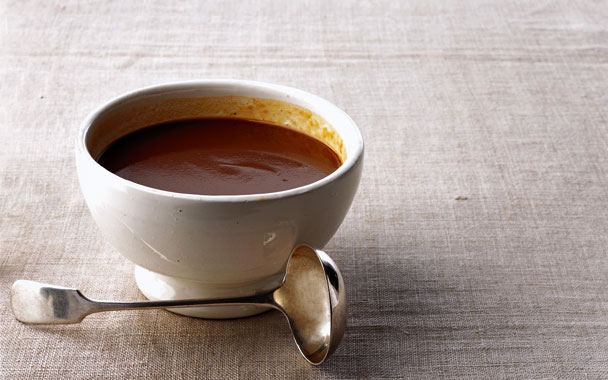What’s New
Robust homemade turkey stock is the foundation upon which truly great gravies are made. But let’s be realistic: Who really has the time on Thanksgiving morning to nurse a gently simmering pot of turkey parts and the accompanying onions, celery, herbs, and spices?
Senior food editor Alexis Touchet came up with a way of solving this problem: She went to the supermarket well in advance of the holiday and bought packages of turkey wings, thighs, and drumsticks. She then browned the turkey parts and premade the stock (Brown Turkey Stock), which can be stored in the freezer for as long as three months or kept in the refrigerator for up to a week.
To take your gravy to yet another level, you can first make the brown turkey stock, then use some of it in place of chicken broth in the Turkey Giblet Stock. In other words, use one stock to make another stock, resulting in a superstock as the liquid for your gravy. Not many of us would go that far, but if you do, the deep, rich flavor of this gravy could well steal the Thanksgiving show.
Tried & True
Choosing the Bird
As it roasts, the turkey itself contributes two important flavor components of delicious gravy—juices with fat, and the brown bits that cling to the bottom of the pan. So the bird you use has a definite influence on the gravy you end up with.
· Kosher turkeys have good flavor but, because they are minimally processed, may still have some feathers to pluck, which can be disconcertingly labor-intensive at a time when every minute is precious.
· We like the idea and, generally, the taste of free-range poultry, but we must admit that we have found some of these birds to be more than a little tough.
· We try to buy organic or naturally raised turkeys, but the supermarket turkeys we tested were surprisingly good.
· A word of caution on brined birds: Whatever your turkey soaks in (including salt alone) will become intensified in the pan juices and brown bits.
Defatting Pan Juices
· There are two schools of thought on the best method to separate pan juices from fat. Half of our food editors prefer a traditional fat separator, in which the fat floats to the top and the juices are then poured out through a spout located low on the vessel. The others simply skim the fat off the juices with a large, shallow spoon after the juices have been strained. There’s no right or wrong here: So long as you get the job done—a clear separation of fat and juices—the choice is yours.
Deglazing
· Deglazing is the culinary term for adding liquid to a hot pan and scraping up the brown bits left from the meat or vegetables—those caramelized nuggets that pack a flavor punch. You can simply add stock to the pan and then scrape up the brown bits on the bottom, but for another flavor component, try substituting dry white wine, Port, medium-dry Sherry, or even Madeira for the deglazing stock (up to 1 cup for our Rich Turkey Gravy).
Thickening
· For the richest taste, thicken your gravy by making a roux, which is a mixture of fat and flour cooked together until the flour no longer tastes raw. This is the method we used for the Rich Turkey Gravy.
· An alternative is to stir cornstarch into room temperature stock until the cornstarch is dissolved, and then whisk that mixture into hot stock combined with the pan drippings. You will sacrifice the richness of gravy made with a roux, but the reward is a glistening, translucent gravy that has a light texture and clean taste. It is also lower in fat.
Making Dark Brown Gravy
· There are several ways to ensure that you end up with a dark brown gravy. The most direct is to thoroughly brown the turkey parts and vegetables that go into your stock, as we’ve done in the recipe here.
Another option is to cook your roux (whisking constantly) until it becomes the color of peanut butter, about 20 minutes.
A shortcut is to add a little soy sauce to the gravy (about 1 tablespoon to 8 cups). You’ll get the color, but, rest assured, your gravy won’t taste like soy sauce.
Vegetarian Gravy
· There’s no need for your vegetarian guests to miss out on rich gravy to pour over the dressing and mashed potatoes. We have created a vegetable-stock-based gravy made with mushrooms and shallots (Roasted Vegetable Gravy) that is so aromatic and delicious it may even entice a few carnivores to pass up the traditional version.



 Pinterest
Pinterest






